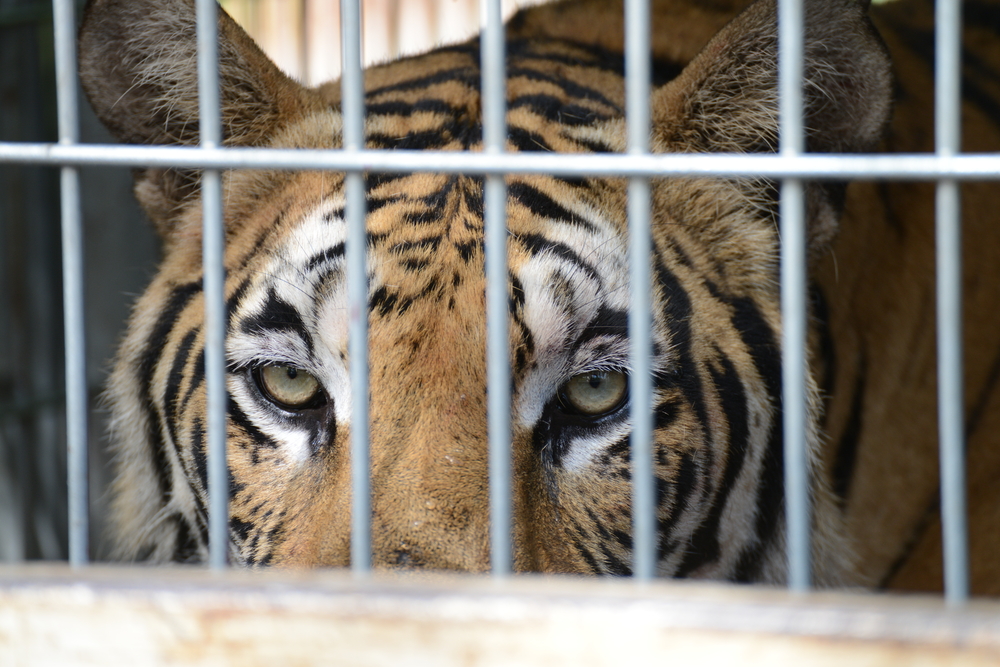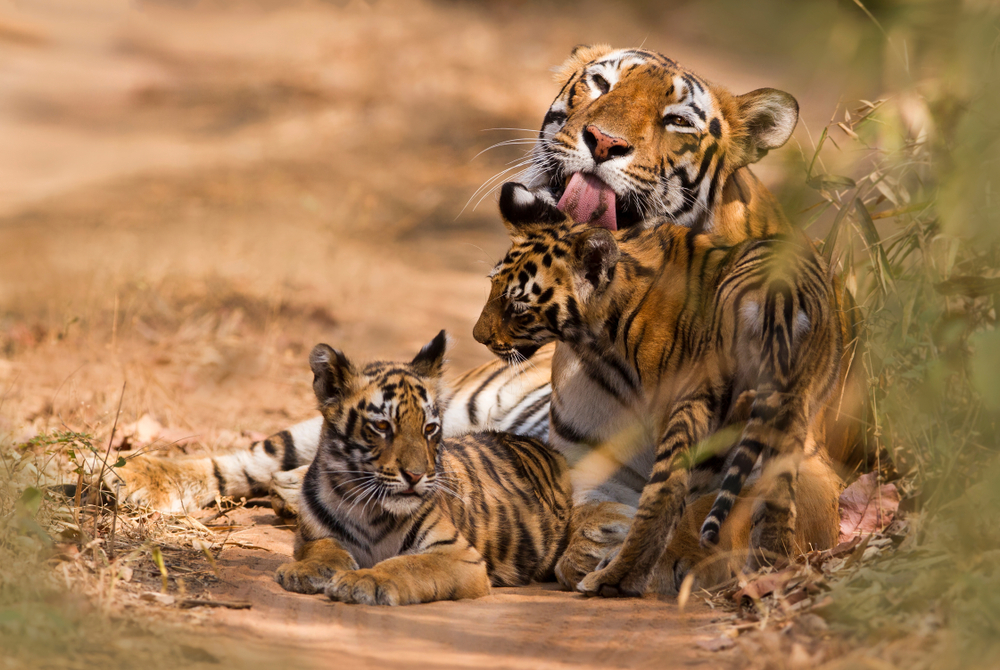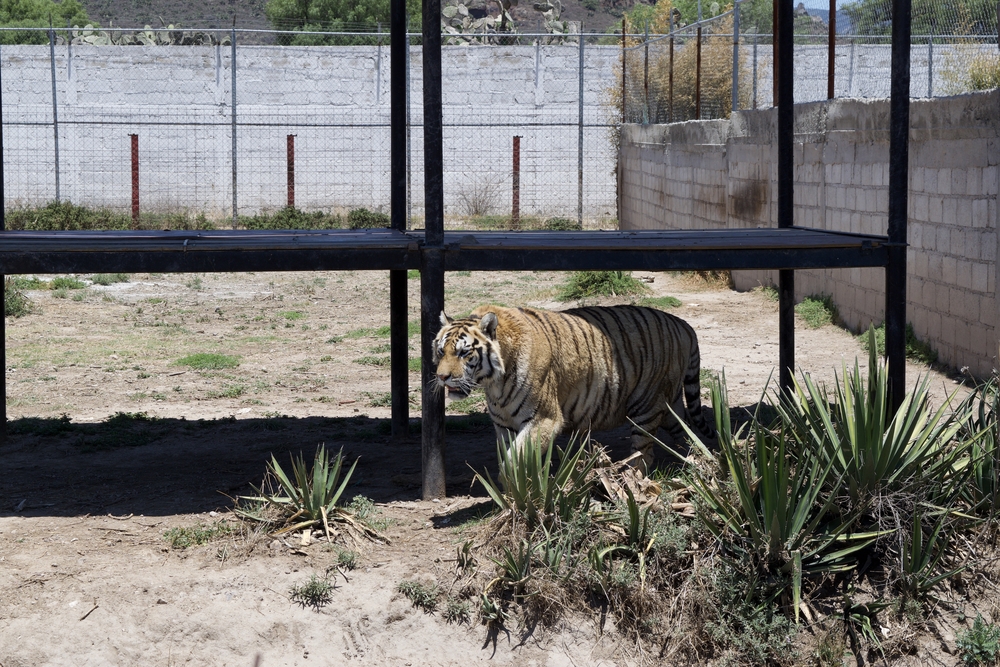
The illegal tiger trade poses serious threats to the survival of these magnificent creatures in the wild. A recent study analyzed seizures of tiger parts trafficked through US ports of entry between 2003 and 2012. It found that the amount of tiger parts trafficked into the country illegally was larger than previously reported. According to the study, 65.8% of the seized parts were from a known origin – and 99.5% came from wild tigers.
Currently, the estimated 4,500 remaining wild tigers are seriously threatened by poaching to meet the ever-growing demand for exotic pets and tiger parts. About 100 years ago, there were 100,000 tigers representing nine subspecies globally. Tragically, only about 4% are left, and three subspecies are already extinct. The remaining ones are classified as endangered or critically endangered tigers, facing imminent extinction in the next few years.
Still, reports show an estimated three times as many tigers in captivity as in the wild. Captive-breeding operations for tigers and other big cats have expanded to meet increasing product demand. Tiger parts have a high market value, and with an estimated illegal wildlife trade value of about $20 billion per year, the illegal tiger trade industry is likely to persist.

Illegal tiger breeding farms are captive facilities that breed tigers, keeping them in captivity and exploiting them for various purposes, including the illegal trade in tiger parts and products. They operate contravention of national and international laws and regulations.
According to WWF, the number of tigers in these farms has increased in recent years, with about 8,000 tigers reportedly held in over 200 facilities across East and Southeast Asia, mostly in China, Viet Nam, Lao PDR, and Thailand. The WWF believes that these farms:
These concerns are justifiable, as there is considerable evidence indicating that a significant percentage of tigers killed by poachers are transported from countries like Russia, India, Malaysia, Indonesia, and Nepal. It is noteworthy that all these countries allow tiger farms to operate within their borders.

Unfortunately, tiger body parts, such as bones, skins, teeth, and claws, are highly valued in some cultures, where they are believed to have medicinal properties and are used in various remedies and tonics. There is also a demand for tiger products as luxury goods, like rugs, jewelry, and decorative items.
Tigers are also desired as exotic pets by some people who are willing to pay large sums of money to own these magnificent creatures. This demand fuels the growth of breeding farms and the exploitation of wild tigers.
The high demand for tigers and tiger body parts fuels the illegal trade as consumers are willing to pay significant sums for the products. This makes it an attractive business for criminals, especially since the associated risks are lower. Compared to other serious crimes like human trafficking or drug smuggling, the penalties associated with wildlife trafficking may be lighter.
Illegal tiger breeding farms have significant ecological and environmental consequences that harm the tiger species and their habitats. Here are some of the key implications:
Illegal tiger breeding farms often require large spaces to accommodate captive tigers. These farms often encroach upon natural habitats, leading to deforestation and habitat destruction. Clearing land for such operations contributes to the loss of critical tiger habitats, which are already under pressure from human activities.
Illegal breeding farms prioritize specific traits or physical characteristics desired by the black market, such as rare coat colors or other unique features. This selective breeding can lead to a loss of genetic diversity within the captive tiger population. Limited genetic variation reduces the resilience of tigers to diseases, environmental changes, and other threats.
The existence of tiger farms, whether legal or illegal, can perpetuate the demand for tiger parts, skins, and products. This demand, in turn, fuels the poaching of wild tigers as a source to meet the market demand for illegal tiger products. The natural tiger populations face significant threats from poaching, habitat loss, and human-wildlife conflict, and the presence of breeding farms can exacerbate these threats by sustaining the demand for tiger parts.
The presence of illegal breeding farms undermines legitimate tiger conservation efforts. These farms operate outside the regulatory frameworks and standards set by reputable conservation organizations. The unregulated breeding and trade associated with these farms can create confusion and mistrust among the public, affecting support for genuine habitat restoration and conservation initiatives.
Some illegal tiger breeding farms serve as fronts for the laundering of illegally sourced tiger parts into the legal market. By producing captive-bred tigers or their derivatives, these farms may attempt to disguise or legitimize illegally obtained tiger products, making it challenging to differentiate between legal and illegal tiger specimens. This undermines law enforcement efforts to combat the illegal trade and contributes to the ongoing trafficking of tiger parts.

Sanctuaries play a critical role in the rescue and lifetime care of abused, neglected, or abandoned tigers. They:
As an individual, there are several actions you can take to contribute to the conservation and protection of tigers. You can educate yourself about tigers, their habitats, and their challenges so you can advocate effectively and make informed choices. You can also spread awareness, choose sustainable products, and support reputable sanctuaries and organizations in their efforts to combat illegal breeding trafficking and exploitation of tigers.
There are many ways to support sanctuaries and organizations that work toward protection of tigers. You can make financial donations or even volunteer your time or skills to help with animal care, habitat maintenance, educational programs, or fundraising activities.
Kallie's story begins with a distressing past, as she was one of four big cats trapped in a defunct drive-thru roadside zoo in Oklahoma. The facility, once open to the public, exploited these majestic creatures for cub petting and photo opportunities, subjecting them to an environment that was neither safe nor conducive to their well-being.
The numerous safety and welfare violations led to the zoo’s shut down in 2008 by the USDA. The zoo and its owner had ties to the notorious "Tiger King" and his shady dealings, further highlighting the exploitative nature of such operations.
The rescue mission was challenging as the animals had been kept in dangerous and difficult-to-access enclosures, resulting in severe health issues. The rescue team conducted on-site evaluations, overseen by a licensed veterinarian, to assess the health and well-being of each big cat. Once they were deemed fit to travel, Kallie and her fellow rescued cats were safely contained in transfer cages for transport to their new homes.
Kallie had endured the cruel standard practice of declawing, which is prevalent in the cub-petting industry. Additionally, she suffered from metabolic bone disease and malnutrition due to inadequate care and nutrition during her time at the roadside zoo. Her living conditions were appalling, as she was confined alone in a dilapidated enclosure for many years, which left her extremely fearful and timid when finally rescued.
Today, Kallie is living a life she always deserved—one of peace and dignity. Her remarkable recovery serves as a testament to the resilience of these majestic creatures and the positive impact that proper care and a nurturing environment can have on their well-being. Kallie's story, along with those of the other rescued big cats, stands as a poignant reminder of the urgent need to protect animals from exploitation in the cub-petting industry and roadside zoos.

Ph: 619.659.8078
Fx: 619.659.8841
[email protected]
24402 Martin Way, Alpine, CA 91901